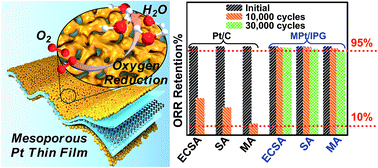A facile synthetic route for highly durable mesoporous platinum thin film electrocatalysts based on graphene: morphological and support effects on the oxygen reduction reaction†
Abstract
Porous-structured noble metal electrocatalysts offer activity and durability benefits based on a high surface area and interconnected nanostructure, respectively. However, conventional technical methods used for synthesizing a porous structure are still difficult as well as resulting in defects in the structure. Here we report a facile route for the synthesis of uniform, large-area mesoporous platinum thin films based on ionic polymer doped graphene, which exhibit substantially enhanced activity and durability for oxygen reduction relative to commercial Pt/C. Notably, a remarkable durability (≥95% retention of electrochemical activities after 30 000 cycles of intensive accelerated durability tests) is acquired which is ascribed to the synergistic effects derived from the interconnected Pt structure (morphology) and ionic polymer-doped graphene (support). The suggested robust concept for a controlled mesoporous-structured platinum thin film on graphene could be a great breakthrough for obtaining a highly durable electrocatalyst.


 Please wait while we load your content...
Please wait while we load your content...